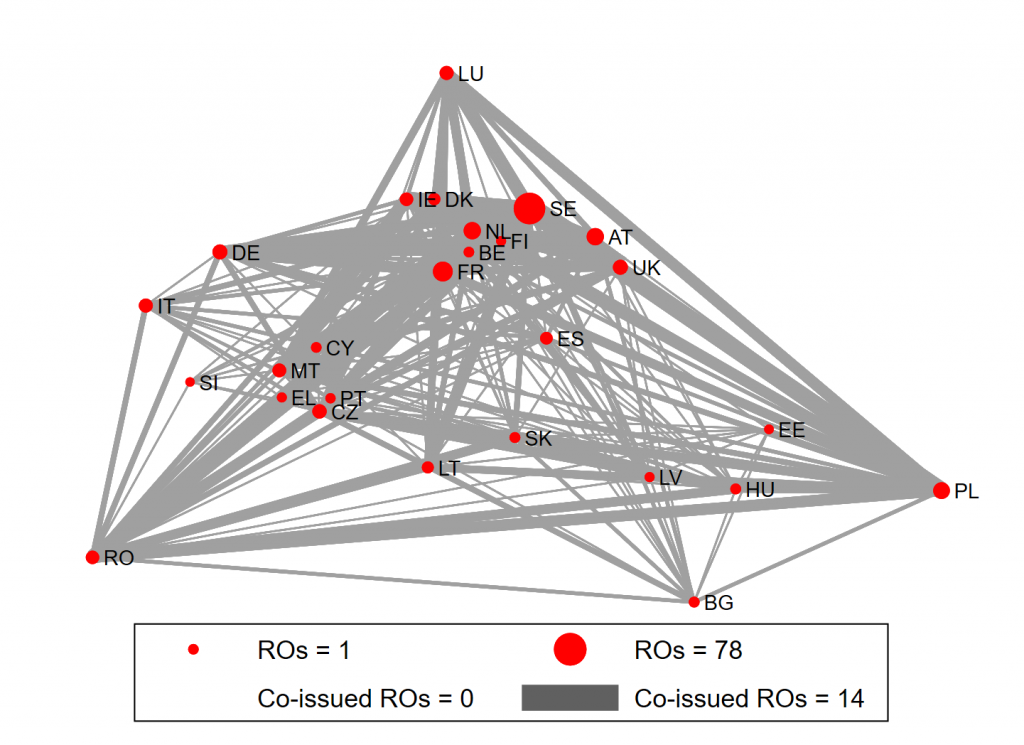The EU’s Early Warning System allows national parliaments to object to proposed legislation. Formally, the objections should be about breaches of subsidiarity – the EU overreaching beyond its competencies. Yet in a new study, Martijn Huysmans and Philippe van Gruisen provide evidence of a substantive, economic dimension of conflict in the system.
A well-known case regarding the EU’s Early Warning System is the yellow card that was issued against the posted workers directive. Such a yellow card is triggered if at least one third of national parliaments object. In the case of posted workers, some of the objections had explicit economic motivations. In their Reasoned Opinions – the formal name of an objection under the Early Warning System – Central and Eastern European countries like Hungary and Czechia worried about adverse economic consequences.
It is fairly well established that a lot of voting decisions in the EU can be explained by two dimensions of conflict: the left-right dimension that is also present in national politics, and an anti-pro EU integration dimension. Recently, however, an economic dimension of conflict has gained attention. Some policies, like new regulations for posted workers, may benefit richer member states while hurting poorer ones. In a new study, we assess whether there is quantitative evidence for an economic dimension of conflict in the Early Warning System, taking all Reasoned Opinions (national objections) into account.
To study the dimensions of conflict, we look at co-issuance, i.e. when pairs of parliaments issue Reasoned Opinions (object) to the same proposed piece of legislation. Figure 1 below visualises the pattern of co-issuance in the Early Warning System over the period 2010-2018. The parliaments have been positioned on the graph according to their average left-right score (x-axis) and their average GDP per capita (y-axis). Hence, horizontal links represent co-issuance by parliaments with similar levels of economic development, while vertical links represent co-issuance by parliaments with similar left-right ideologies.
Figure 1: Network of Reasoned Opinions (2010-2018)

Note: The parliaments are represented as nodes and the Co-issued Reasoned Opinions as edges connecting the nodes. The node size represents the number of proposals on which at least one chamber of Parliament issued a Reasoned Opinion. It ranges from 1 for Slovenia to 78 for Sweden. For more information, see the authors’ accompanying study.
We investigate whether there is an economic dimension of conflict in the Early Warning System using a series of statistical models. The models regress co-issuance on difference in economic development as measured by GDP. The hypothesis to be tested is that parliaments from countries with big differences in GDP are less likely to co-issue an objection to the same proposals.
The models take into account potentially confounding factors. Examples are distance on the left-right dimension, differences on being in favour of EU integration, and physical distance between the countries. After all, countries may simply co-issue more because they are closer together and hence have similar interests or coordinate more.
Figure 2 below shows that there is indeed statistical evidence for an economic dimension of conflict in the Early Warning System. Parliaments of countries with smaller differences in GDP per capita are more likely to jointly object to legislation put forward by the European Commission.
Figure 2: The probability of parliaments opposing the same piece of legislation

Note: The figure presents the predicted probability of co-issuing Reasoned Opinions between two parliaments as a function of their difference in economic development (GDP per capita). The prediction is based on a statistical logit model, which controls for Left-Right distance, EU anti-pro distance, Contiguity, Juncker Commission, and Year. The horizontal red line shows the baseline probability of co-issuance, equal to 0.8%. For more information, see the author’s accompanying study.
To conclude, even though in theory the Early Warning System is only about breaches of subsidiarity (EU overreaching), in practice it also about the substance of proposed policies. To explain this finding, we suggest that proposals that affect rich and poor member states differently may be more likely to lead to opposition by the disadvantaged group. Future research looking in more detail at the content of each proposal and objections may shed further light on this.
For more information, see the authors’ open access article at the Journal of European Integration
Note: This article gives the views of the authors, not the position of EUROPP – European Politics and Policy or the London School of Economics. Featured image credit: European Council





